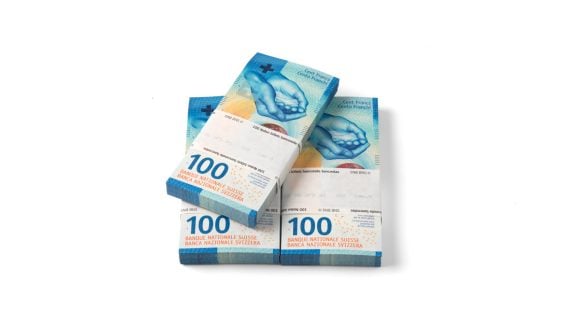
Soon it will be time to say “Arrivederci, Alberto!” The new 100-franc note will replace the previous note featuring the portrait of artist Alberto Giacometti. Reason enough to take a closer look at Switzerland’s most popular banknote.
1. Splish, splash
1. Splish, splash
What’s a “suone”? Every child in Switzerland will soon find out. The 100-franc banknote being issued by the Swiss National Bank (SNB) shows an irrigation channel near the village of Ayent, the Bisse d'Ayent, in the rock face of Torrent-Croix. Suone is the name given to centuries-old irrigation canals in the canton of Valais which were created in a similar mysterious way to the structures of the Machu Picchu in the Andes. By using the element of water, the SNB wants to draw attention to the “humanitarian side of Switzerland”. The color is obvious: blue.
2. Small but effective
The new note is about 40 millimeters shorter and thinner than the first 100-franc note issued in 1907. One hundred 100-franc notes would only be enough to wallpaper one square meter! But “Small is beautiful” is not only true in Switzerland. A trend towards smaller banknotes is also emerging internationally.
3. A winner of hearts
More than one in every four Swiss banknotes is a 100-franc note, making it Switzerland’s most popular banknote. In terms of total value, however, it is the 1,000-franc note which comes in first place. Counterfeiters still prefer to try their hand at 100-franc notes – usually without success. The 100-euro and 100-dollar notes are much more attractive for “counterfeit artists”. For one thing, because their currency areas are much larger.
4. The currency of cheese?
Since its introduction in 1850, the Swiss franc has never been caught up in the whirl of hyperinflation. It experienced its most turbulent downward phase in the early 1970s. Nevertheless, 100 years ago a household could get by for much longer on 100 francs. A 100-franc note used to buy 44 kilos of Gruyère, for example. Today it’s only enough for about 5 kilos. However, a lot of things that are now commonplace for us were unaffordable or unavailable at the time – such as bananas, high-tech goods and antibiotics. In addition, Swiss banknotes have the highest “real value”, with production costs of 40 centimes.
5. Internationally reputed
The Prince of Liechtenstein may have privileges – but there is one thing he cannot do: he isn’t permitted to have banknotes printed. The Swiss franc has been the official national currency of Liechtenstein since 1920. The Principality is only allowed to mint collector and commemorative coins. The franc is also finding its way into Italy and Germany, albeit in very limited areas: it is the official currency of the Italian enclave Campione d’Italia on Lake Lugano. In the German enclave of Büsingen on the Upper Rhine, the franc is also the standard currency over the counter, although the euro remains the legal tender.
No expiry of old banknotes
No expiry of old banknotes
Swiss banknotes no longer have an expiry date. The Council of States and the National Council decided in the spring, after considerable discussion, that they can be exchanged indefinitely in the future. The unlimited exchange period will apply to notes from the sixth series onwards, which came into circulation in 1976. The 100-franc note bears the portrait of architect Francesco Borromini. There are still over a billion francs worth of notes in circulation from this series! What should you do with them? They are no longer accepted by banks and retailers. However, the cash offices and agencies of the Swiss National Bank (SNB) will exchange old banknotes for new ones free of charge.
